In this blog post, I have included some bullet point research that has inspired my initial drawings and sampling. This research has been gathered from Trend websites such as Trend Union, Vogue and WGSN.
THE END OF MORE –
- 2021 minimalist led macro driver with more considered consumption, focusing future product requirements around utility, versatility and longevity.
- Sustainable solutions go hand in hand with the focus on minimalism. Shout about new material innovation and use hero prices that promote longevity for a capsule wardrobe, supporting work, rest and play.
WGSN article – COVID CAPSULE – Design Priorities
- Consumer expectation – need for comfort and protection. Customers will be looking for better connections with their products and will spend with greater intention. Therefore, a better design process to research and develop future proof businesses.
- The environmental crisis and coronavirus crisis are tightly aligned.
- Durable, useful products which serve multiple purposes and can be resold are the new drivers of value. Simplify, curate and edit the proposition around these drivers.
- Lasting lifestyle changes – home working as a norm, will lead to faster shifts in the way we dress. Review and de-risk smart wear and tailoring. Thermoregulating base and mid layers present new selling opportunities for at home use.
- Unspec and smarten key items within the lounge and comfort wear. Position these as new solution dressing beyond the home.
- Fabric and fibre innovation to add value to customers, with heightened awareness around hygiene, health and wellness. Seek out developments in antimicrobial, anti-pollution, self-cleaning and self-healing properties.
- Double down on extreme weather resistance in outerwear. Design in extra protective shield-like elements around hoods or collars.
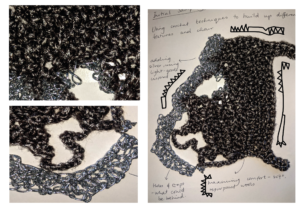
Sample 1 – key focus on contrast, promoting comfort, silver lining past COVID.
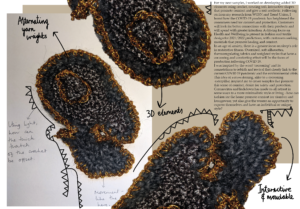
Sample 2 – Manipulating the yarns to create soft edges and rounded forms that reflect the necessities of comfort and safety.

Sample 3 – Using repurposed yarns, plying, 3D forms, interactive textiles
Driving focus on health – Wellness.
A renewed focus on the holistic approach to wellness expected –
- Healing Materials – in fibres, like hemp, natural dyes??Compression wear, recovery wear. How could knit be healing?
- Next to skin softness and intelligent health boosting benefits, such as moisture management and thermoregulation – smart textiles
- Heightened Slumber – In an age of anxiety, focus on sleep’s role in restorative fitness, aided by wearable duvets and tech-led innovations. Soft silhouettes, thermoregulating fabrics and weighted styles will have a cocooning and comforting effect.
- Bath leisure – Merging principles of athleisure, bleisure and slounge, bath leisure repurposes bathroom styles and fabrics such as waffle and towelling.
YARNS –
- Consumer desires comfort and adaptability, mills explore timeless looks that can work hard for leisure, lounge and office. Easy care properties, ethical sourcing and sustainability are also key priorities.
- Transseasonal yarns come to the fore – add extra value to fine-gauge classical yarns such as cashmere and merino with performance abilities such as antibacterial and machine washable
- Choose RWS yarns, organic recycled and functional fibres – utilise new tech and materials such as zinc, ions and graphene which have good antibacterial effects and provide a degree of protection from the skin.
- Tap into the need for comfort – choose cosy fleece yarns, from furry and chenille structures to boiled wool boucle yarn effects for multipurpose dressing, evolving loungewear into heavier winter weights.
- Explore traditional rustic tweeds with added tactility – irregular mixes of nepped, melange and Donegal looks in subdued earthy tones are key alongside boucle, roving and knop constructions with bicolour twists.
- Make use of recycled and deadstock yarns using pieced together patterns – dissolved colours reflect the shift to environmental awareness. Pay attention to undyed, botanical dyes and water-free dyeing.
- Subtle irregular yarns add discreet texture to fine knits, upgrading matching sets and enabling flexibility for dual indoor and outdoor usage.
- Sustainably sourced cashmere, merino, alpaca fibre cable and rib knits are gently felted to become more robust without losing softness.
- Perfect for minimalist trans seasonal silhouettes.
- Blurred volume – lofty and soft loopy boucle and knop yarns are a cosy direction.
- Bouncy, blurry looks inspire new knit directions with brushed up boucle yarns and soft felted looks adding warmth to winter knits.
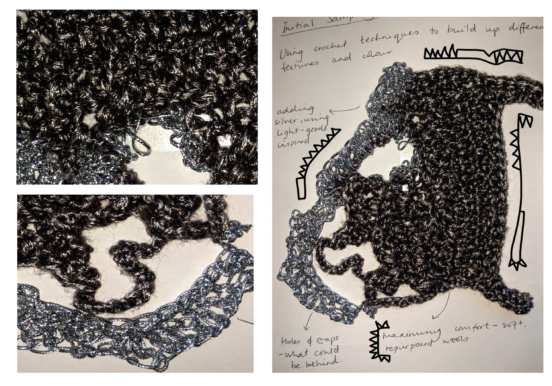

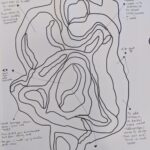
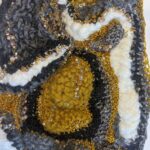
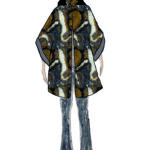
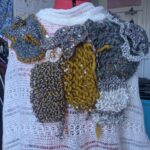
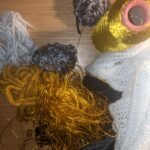

lrichar3
2 December 2020 — 7:41 pm
Really good to see your critical anlysis here. Your use of materials is sophistcated. Your response to the research is utterly convincing, well done. Try to consolidate your intentions. You risk having too broad an ambition here for the limited time to produce your samples. Also take care that you keep your finished sampling focused. remember the limitations of the boards. Only 1 main sample, plus the supporting sampling.